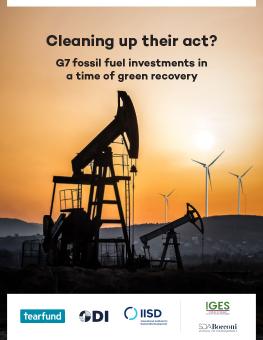
Cleaning Up Their Act? G7 fossil fuel investments in a time of green recovery
The report analyzes all new policies and measures related to energy production and consumption approved by the G7 and other nations invited to attend the 2021 G7 Leaders' Summit (Australia, Canada, France, India, Italy, Japan, Germany, Republic of Korea, South Africa, the United Kingdom, and the United States) between the beginning of the COVID-19 pandemic (taken as January 1, 2020) and March 3, 2021. It assesses the contribution of these policies to building back better and, specifically, their impacts on climate action.
-
Between January 2020 and March 2021, G7 nations have been pumping more money into fossil fuels than clean energy , despite pledges to "build back better". Coal, oil and gas received US$189 billion in support, compared to $147 billion for clean forms of energy.
-
G7 nations missed major opportunities to make their response to Covid-19 greener. More than eight in every ten dollars committed to fossil fuels came with no 'green strings' attached: they benefited fossil-fuel intensive activities without requirements for any climate targets or reductions in pollution.
-
Only one in every ten dollars committed to the Covid-19 response benefited the 'cleanest' energies measures, like renewables or energy efficiency. G7 countries are not yet investing at sufficient scale in technologies that support the fast decarbonization of their economies.
At a time when emission reductions are urgently needed, G7’s COVID-19 response will either accelerate the transition to cleaner, more equitable societies or lock the planet into catastrophic and irreversible climate change. Yet between January 2020 and March 2021, and despite collective pledges to "build back better" and reach net-zero emissions by mid-century, G7 nations have been pumping more money into fossil fuels than they have into clean energy. The window of opportunity is small, but the G7 can still get back on track and support a fossil-free recovery. The G7 Leaders’ Summit is the opportunity to send the right signal to the world and take concrete steps toward building back better.
This report recommends that the G7:
- Adopt a "do-no-harm" principle by ending any support to the production of fossil fuels and by attaching significant "green strings" to any remaining support to fossil fuel-intensive sectors.
- Dedicate a minimum of 40% of total COVID-19 recovery spending to green policies and measures (the current figure is 22%, according to the Global Recovery Observatory).
- Enable a green recovery for all by continuing to ease the debt burden faced by a rising number of low- and middle-income countries by doubling climate finance pledges, ending overseas finance to fossil fuels, and using the G7’s influence on multilateral development banks to align their activities with the Paris Climate Agreement.
The report uses data from the Energy Policy Tracker and draws on findings from other recovery trackers such as the Greenness of Stimulus Index, the Green Recovery Tracker, and the Global Recovery Observatory. It analyzes a total of 517 policies approved between January 1, 2020, and March 3, 2021.
Participating experts
You might also be interested in
Securing India's Copper Supply
This policy brief emphasizes the need for India to develop a comprehensive copper strategy.
The Indonesia Cooking Diaries Study
This study evaluates the feasibility and implications of switching from cooking with LPG to induction stoves in Indonesian households.
Report Calls on Fossil Fuel Producers to Map “Transition Away” in NDCs
With governments due to submit the next generation of NDCs in 2025 a new report identifies five elements countries should include to reflect the outcome of the global stocktake.
Ending Canadian Domestic Public Financing for Fossil Fuels
This report examines the scope of public financing for the fossil fuel sector in Canada and makes recommendations for Canada's forthcoming policy to eliminate this financing.